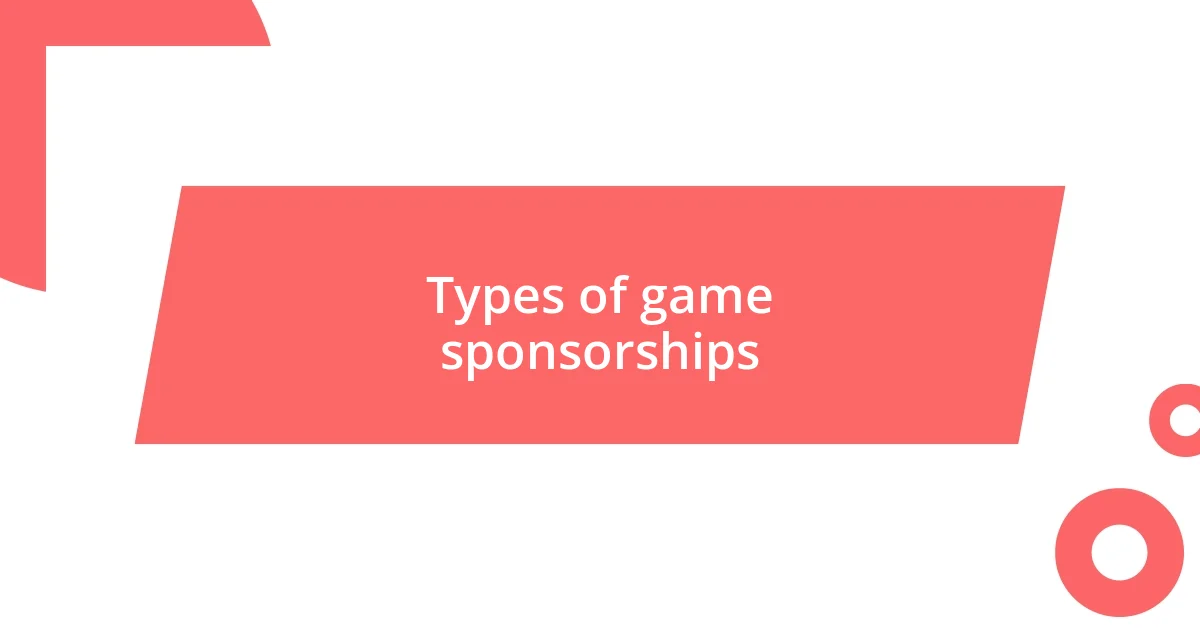Key takeaways:
- Game sponsorships enhance the sports experience by providing financial backing, fostering community engagement, and supporting athlete development through various types of partnerships.
- Effective sponsorship proposals require clarity, emotional connection, and an emphasis on mutual benefits to attract sponsors and create successful collaborations.
- Measuring sponsorship success involves evaluating emotional engagement and long-term impact, rather than just financial metrics, to understand the depth of the partnership’s influence on the community.

The importance of game sponsorships
Game sponsorships play a crucial role in the sports industry. I remember the first time I attended a sponsored event; the atmosphere was electric, and the support from brands made the game feel larger than life. Have you ever noticed how a well-placed sponsor can elevate the experience for fans and players alike?
Sponsorships not only provide financial backing for teams and events but also foster a sense of community and shared values. When I see a local business supporting my favorite team, it feels like they’re part of my journey as a fan. Isn’t it inspiring to think about how these partnerships can unite a community around something they all love?
Moreover, these partnerships enable teams to invest in better facilities, training, and outreach programs. I recall hearing about a team that secured a major sponsorship and used the funds to develop youth programs in underserved areas. How impactful is it when companies commit to nurturing the next generation of athletes? Game sponsorships are more than just financial transactions; they are lifelines that can change lives and strengthen communities.

Types of game sponsorships
Sponsors can partner with teams in various ways, each offering unique benefits. One type is team sponsorship, where a brand’s logo adorns uniforms and promotional materials. I recall a local rugby team sporting a prominent logo; it was exciting to see how that partnership not only boosted the team’s visibility but also drove sales for that brand. Who doesn’t love the thrill of spotting your favorite brand on the pitch?
Another fascinating category is event sponsorship, where companies support tournaments or competitions directly. I remember attending a local esports event; the branding and promotional materials from the sponsors were everywhere! This level of engagement creates a festive atmosphere and often leads to exciting giveaways or contests, elevating the experience for everyone involved.
Finally, there’s athlete sponsorship, where individual players are backed by brands. I once followed a rising star in basketball who had a deal with a well-known sneaker company. Watching her journey not only inspired me as a fan but also showcased how personal branding can be both rewarding and motivational. These sponsorships resonate deeply, reminding us how interconnected our favorite games and the brands we love can be.
| Type of Sponsorship | Description |
|---|---|
| Team Sponsorship | Brand logos on team uniforms, enhancing visibility and support. |
| Event Sponsorship | Companies support tournaments, creating engaging experiences for fans. |
| Athlete Sponsorship | Individual players backed by companies, showcasing personal branding. |

Benefits of game sponsorships
Game sponsorships bring a multitude of benefits that extend far beyond financial support. Personally, I’ve seen how sponsorships help elevate the status of both the teams and the events they back. For instance, I attended a local football match where the sponsor had arranged for thrilling halftime entertainment, transforming it into a vibrant community gathering. That experience left me feeling more connected to the game, knowing that the sponsor genuinely cared about enhancing our enjoyment.
Here are some advantages that stand out to me:
- Financial Stability: Sponsorships provide essential funding that allows teams to operate smoothly and sustainably.
- Enhanced Visibility: Brands gain exposure through logo placements, creating a connection with fans and boosting customer loyalty.
- Event Experience: Sponsors can elevate game day experiences through promotions, giveaways, and entertainment that engage the audience.
- Community Impact: Partnerships often support local initiatives, fostering goodwill and deeper roots within the community.
- Athlete Development: Sponsorship funds can be allocated towards youth programs, ensuring future talent has the resources and support they need to thrive.
I find it particularly heartwarming when a sponsor invests in grassroots initiatives. The other day, I stumbled upon a community soccer program funded by a major brand. It was incredible to see how those sponsorship dollars were nurturing young talent; it felt like a cycle of support where today’s players might become tomorrow’s role models, all influenced by a thoughtful partnership.

Challenges in securing sponsorships
Securing sponsorships can sometimes feel like navigating a maze filled with obstacles. One of the main challenges I’ve seen is the sheer competition in the sports industry. With countless teams vying for the same brands, standing out becomes critical yet increasingly difficult. I remember working with a local esports team, and despite their impressive following, they struggled to get attention from brands that were more focused on bigger leagues. It’s disheartening when potential partners overlook talent because they’re blinded by the allure of higher-profile teams.
Another hurdle lies in the shifting priorities of potential sponsors. Brands often have specific metrics they focus on, such as audience demographics and market trends. I’ll never forget discussing sponsorship with a well-known beverage company; they were keen on data that proved fan engagement but were hesitant because the demographics of our fanbase didn’t perfectly align. It’s a stark reminder that while passion can drive the game, concrete numbers can often overshadow that enthusiasm in the boardroom.
Finally, navigating the negotiation process adds another layer of complexity. When I was involved in securing a deal for a regional sporting event, I learned firsthand how tricky it is to balance the expectations of both parties. Sponsors often want significant visibility for a relatively low investment, while teams need adequate funding for their operations. Finding a common ground requires patience and creativity, and there were moments I felt like we were miles apart. But when we finally reached an agreement, the sense of accomplishment was truly rewarding. It’s all about building relationships alongside business.

Evaluating potential sponsors
Evaluating potential sponsors requires a nuanced understanding of not just the financial aspects but also the values and goals they bring to the table. I once met with a tech company interested in sponsoring a local gaming tournament, and what struck me was their passion for innovation and community engagement. Their vision for enhancing the tournament experience resonated with me, highlighting how shared values can lead to a partnership that feels more like a collaboration than a transaction. Isn’t it refreshing when brands align closely with the spirit of the event?
Diving deeper into the relationship potential, I learned that the best sponsorships often stem from genuine connections rather than surface-level agreements. For example, a local coffee shop I know decided to support a youth sports league, not just for exposure, but because they wanted to invest in the community where their customers lived. Their involvement added a personal touch to the sponsorship that truly made a difference in the players’ lives. Couldn’t we all benefit from partnerships that prioritize community over mere visibility?
Finally, I believe that assessing the long-term vision of a potential sponsor is crucial. It’s about more than just immediate financial support; I remember discussing with a major outdoor brand that aimed to sponsor environmentally-conscious projects. Their commitment inspired me to think beyond the present moment and consider how that partnership might cultivate a legacy for future events. How can we ensure that our sponsors aren’t just in it for the short term, but are dedicated to fostering sustainable growth in the communities they touch?

Creating effective sponsorship proposals
Creating effective sponsorship proposals hinges on clarity and specificity. When I was tasked with crafting a proposal for a regional gaming event, my first step was to articulate precisely what we offered. It wasn’t just about visibility but also about targeting specific demographics that aligned with the sponsor’s goals. I remember thinking, “What can we provide that they can’t ignore?” By highlighting our unique community engagement and potential reach, we positioned ourselves as an invaluable partner rather than just another option.
Moreover, I discovered that personal connection plays a huge role in proposals. In one situation, I reached out to a local brand that had a fondness for gaming culture. Instead of just showcasing statistics, I included a heartfelt story about how gaming positively impacted local youth—something they genuinely cared about. I found that using real-life narratives made the proposal feel more authentic. Isn’t it powerful when a proposal resonates on an emotional level, rather than just being filled with numbers and jargon?
Lastly, don’t forget the importance of showcasing mutual benefits. When I negotiated a sponsorship with a regional gaming café, I made it clear how their support would lead to joint promotional opportunities. By emphasizing the collaborative aspects and painting a vision of success for both parties, I could see their eyes light up. It’s all about creating a win-win scenario, where everyone feels they are gaining something meaningful. How can we ensure our proposals spark excitement and foster genuine partnerships?

Measuring sponsorship success
Measuring sponsorship success goes beyond just financial metrics—it’s about the emotional and relational impact of the partnership. In my experience with a gaming event sponsored by a well-known energy drink brand, we tracked not just the sales increase, but the participants’ enthusiasm and engagement. The buzz around the brand during the event made it clear that their involvement had ignited a deeper connection with the community. Isn’t it fascinating how emotional engagement can often trump mere numbers?
Another key aspect I’ve found essential in gauging sponsorship success is direct feedback. At a tournament I organized, we distributed surveys to attendees after the event, asking them to rate the sponsor’s presence and impact. The responses illuminated how the brand’s activations, like interactive booths and giveaways, enhanced the overall experience. How often do we think about how our audience perceives these partnerships? Understanding their perspective can provide invaluable insights for future sponsorship strategies.
Lastly, consider the long-term effects of a sponsor’s presence. A few years back, a major gaming peripheral company joined forces with our festival. We evaluated success by looking at the growth in brand loyalty among participants over time. The repeated engagement created not only brand advocates but also a sense of identity within our community. When we think about measuring success, shouldn’t we also reflect on how these partnerships shape the culture and values we uphold?















